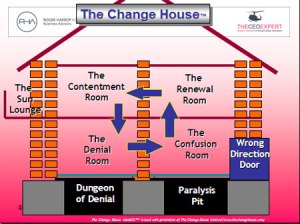People typically go through different changes of stage. This blog explains the Four Rooms of Change with an example.
Change is about emotions. Nobody likes change, but we all deal with it in a different way. According to the Four Rooms of Change theory (often incorrect referred to as the Change House Model) we all go through different phases in the change process. Everybody can be in a different phase and we all have a different pace when evolving through it.
Let’s explain with an example
Recently Google, Apple and Amazon have entered the banking business. During their success in the last decennium they acquired a big cash position and now offer financial services like credit cards and commercial loans.
When we don’t see the need to change, we’re in The Contentment Room of the change house. Our current situation is satisfying and we have no desire to change anything. We’re doing banking on our way for years and it pays off. Why change? People might even get stuck in this situation and exit to The Sun Lounge.
When Google makes their big move, we will be caught off guard.
Suddenly a certain event happens: new companies like Google and Apple enter the banking business. We are triggered into the next phase, The Denial Room. Yet, we don’t see the risk. Why should we change? Google hasn’t got the banking experience like us and our customers are most familiar with our bank and our ways. The possible threat is not seen as such. People even might get stuck in this phase and fall in The Dungeon of Denial.
When the need for change is accepted, you enter The Confusion Room. In this phase, emotions like fear, anger, and (internal) conflict take over. The situation is new to us and we don’t know how to react. How can we compete with Google? Are they also entering the mortgage market? What are other banks doing? I should have seen this coming… they had such a big cash position. It takes dedication and commitment to get to the next phase.
The risks in this phase are overanalysing the current situation and possible outcomes in The Paralysis Pit, or just plain giving up via the Wrong Direction Door.
When it all falls together, we’re in the The Renewal Room. We have made up our minds, we worked out a new approach and are ready to take up the challenge. We know how to deal with the new threat, we trained our clerks to respond to customer questions about Google, etc. But the journey doesn’t end here, we should prepare ourselves for another ride through the house. We don’t know what’s up next.
What can we do to help people going through the change?
Make people aware of their position in the change house:
- Share the theory and use an example applicable for your situation. Other examples then explained above are:
- News paper industry vs. the Internet.
- Book press industry vs. the Amazon Kindle.
- ICQ and MSN Messenger vs. Facebook chat.
- The phone industry vs. Skype.
- Nokia vs. the smart phone with touch interface industry.
- Classic mortgage loans vs. public loans (Dutch: volkslening).
- Fund investments vs. direct investments into wind energy parks by individuals.
- People which are in denial (of the change) are most often hard to deal with because they’ll also deny that they’re in the Denial phase.
- Emphasize on the need for change. Provide facts.
- Repeat the why of the change on every opportunity you have (eg. coffee machine, meeting, presentation).
- Don’t ignore, but acknowledge feelings. Listen to what they have to say. Talk to them, put it on the table.
- Involve people who resist. They still use their energy to complain and give feedback. Try to use this energy in your advantage. The ones who react apathetic or have given up will be more difficult to get on your side.

[…] I saw a team compass which uses the theory of the “4 rooms of change”. While it’s best used in big change projects, it expresses how team members feel about the […]